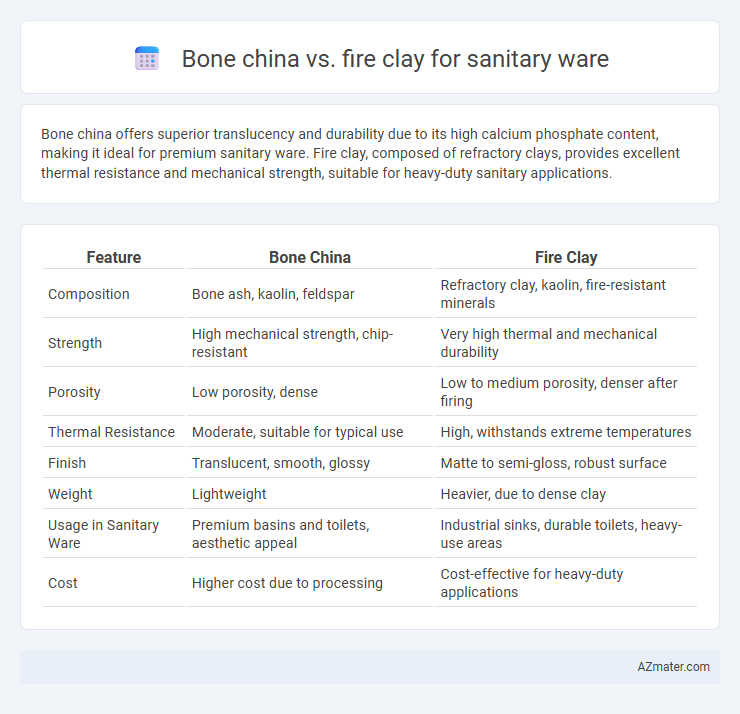Bone china offers superior translucency and durability due to its high calcium phosphate content, making it ideal for premium sanitary ware. Fire clay, composed of refractory clays, provides excellent thermal resistance and mechanical strength, suitable for heavy-duty sanitary applications.
Table of Comparison
| Feature | Bone China | Fire Clay |
|---|---|---|
| Composition | Bone ash, kaolin, feldspar | Refractory clay, kaolin, fire-resistant minerals |
| Strength | High mechanical strength, chip-resistant | Very high thermal and mechanical durability |
| Porosity | Low porosity, dense | Low to medium porosity, denser after firing |
| Thermal Resistance | Moderate, suitable for typical use | High, withstands extreme temperatures |
| Finish | Translucent, smooth, glossy | Matte to semi-gloss, robust surface |
| Weight | Lightweight | Heavier, due to dense clay |
| Usage in Sanitary Ware | Premium basins and toilets, aesthetic appeal | Industrial sinks, durable toilets, heavy-use areas |
| Cost | Higher cost due to processing | Cost-effective for heavy-duty applications |
Introduction to Bone China and Fire Clay
Bone china is a type of porcelain characterized by its high levels of bone ash, feldspathic material, and kaolin, resulting in a durable, translucent, and white ceramic ideal for delicate yet sturdy sanitary ware. Fire clay, a refractory ceramic material composed primarily of refractory clays, offers superior heat resistance and mechanical strength, making it suitable for heavy-duty sanitary ware applications. Both materials provide unique benefits in sanitary ware, with bone china focusing on aesthetic appeal and refinement, while fire clay prioritizes robustness and thermal durability.
Composition and Material Properties
Bone china contains a high percentage of bone ash (typically 30-40%), feldspar, and kaolin, which contribute to its translucency, whiteness, and high mechanical strength. Fire clay, composed mainly of refractory clay rich in alumina and silica, is highly heat-resistant and offers excellent durability and thermal shock resistance. Bone china provides superior aesthetic appeal and chip resistance, while fire clay's robust composition makes it more suitable for heavy-duty applications in sanitary ware.
Manufacturing Processes Compared
Bone china for sanitary ware involves combining bone ash, kaolin, and feldspar, then undergoing high-temperature firing around 1200-1250degC, resulting in a dense, translucent, and durable product with a smooth finish. Fire clay manufacturing includes mixing refractory clays and other minerals, shaped then fired at higher temperatures near 1300-1400degC, producing a robust, heat-resistant, and heavier ceramic ideal for high-stress applications. Differences in raw materials and firing temperatures influence porosity, strength, and thermal shock resistance, making bone china preferred for aesthetic quality and fire clay favored for structural endurance.
Durability and Strength Differences
Bone china exhibits high strength and translucency due to its bone ash content, making it less prone to chipping but generally more fragile under heavy impact compared to fire clay. Fire clay, composed primarily of refractory clays, offers superior durability and resistance to thermal shock, making it ideal for heavy-duty sanitary ware applications requiring robust structural integrity. The dense, vitrified nature of fire clay enhances its mechanical strength, outperforming bone china in long-term wear and impact resistance.
Aesthetic Appeal and Finish
Bone china sanitary ware exhibits a smooth, glossy finish with a translucent, elegant appearance that enhances bathroom luxury and aesthetic appeal. Fire clay offers a more matte, robust surface with a natural, earthy texture, appealing to rustic and traditional design preferences. The choice between bone china and fire clay significantly impacts the visual tone and finish quality of bathroom fixtures, with bone china emphasizing refinement and fire clay showcasing durability and texture.
Water Absorption and Stain Resistance
Bone china sanitary ware exhibits low water absorption rates, typically below 0.1%, which enhances its resistance to moisture-related damage and staining. Fire clay products have slightly higher porosity, resulting in water absorption values ranging from 0.1% to 0.5%, making them less resistant to stains and requiring more frequent maintenance. The superior vitrification process in bone china ensures better durability against chemical stains and easier cleaning in sanitary applications.
Cost Analysis: Bone China vs Fire Clay
Bone china sanitary ware incurs higher production costs due to the use of refined materials like bone ash and longer firing times, resulting in a premium price point. Fire clay, made from natural clays and fired at high temperatures, offers a more cost-effective alternative with durable properties but generally lower aesthetic appeal. The cost difference directly impacts consumer pricing, with bone china positioned in the luxury segment and fire clay targeted at budget-conscious markets.
Environmental Impact and Sustainability
Bone china production involves the use of animal bone ash, which raises ethical concerns and limits its sustainability compared to fire clay, a naturally abundant material. Fire clay requires lower firing temperatures, leading to reduced energy consumption and a smaller carbon footprint in sanitary ware manufacturing. The durability and recyclability of fire clay products further enhance its environmental advantages over bone china in sustainable bathroom solutions.
Popular Applications in Sanitary Ware
Bone china is widely used for premium sanitary ware items such as washbasins and toilet bowls due to its high strength, translucency, and smooth finish, making it ideal for luxury bathroom fixtures. Fire clay, known for its exceptional durability and resistance to high temperatures and chemicals, is commonly utilized in commercial and industrial sanitary ware applications like heavy-duty sinks and floor-mounted toilets. Both materials offer distinct advantages, with bone china favored for aesthetic appeal and fire clay prioritized for robustness in demanding environments.
Choosing the Best Material for Your Needs
Bone china offers a smooth, translucent finish with high mechanical strength and excellent chip resistance, making it ideal for premium sanitary ware requiring elegance and durability. Fire clay, composed of refractory clays fired at high temperatures, provides superior hardness and stain resistance, perfect for heavy-use environments demanding robust performance. Selecting between bone china and fire clay depends on prioritizing aesthetic refinement versus uncompromising durability in your sanitary ware applications.

Infographic: Bone china vs Fire clay for Sanitary ware
 azmater.com
azmater.com